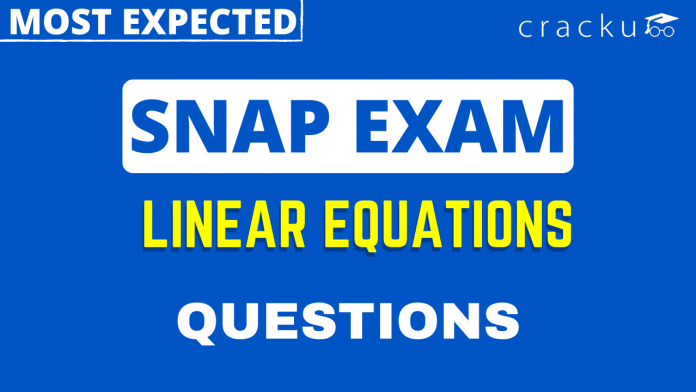SNAP Linear Equations Questions PDF
The Linear Equations is an important topic in the Quant section of the SNAP Exam. You can also download this Free Linear Equations Questions for SNAP PDF with detailed answers by Cracku. These questions will help you practice and solve the Linear Equations questions in the SNAP exam. Utilize this PDF practice set, which is one of the best sources for practicing.
Download Linear Equations Questions for SNAP
Enroll to SNAP 2022 Crash Course
Question 1: In 1 kg of a mixture of sand and iron, 20% is iron .How such sand should be added so that the proportion of iron becomes 10%
a) 1 kg
b) 200gm
c) 800 gm
d) 1.8 kg
e) None of these
1) Answer (A)
Solution:
Total mixture of sand and iron = 1 kg
Quantity of iron = $\frac{20}{100} \times 1 = 0.2$ kg
Let $x$ kg of sand should be added, thus total iron in the mixture
=> $0.2=\frac{10}{100} \times (x+1)$
=> $2=x+1$
=> $x=2-1=1$ kg
=> Ans – (A)
Instructions
Each of the questions below consists of a question and two statements numbered I and II given below it. You have to decide whether the data provided in the statements are sufficient to
answer the question. Read both the statements and answer the below questions
a: if the data in Statement I alone are sufficient to answer the question, while the data in Statement II alone are not sufficient to answer the question.
b: if the data in Statement II alone are sufficient to answer the question, while the data in Statement I alone are not sufficient to answer the question.
c: if the data either in Statement I alone or in Statement II alone are sufficient to answer the question.
d: if the data even in both Statements I and II together are not sufficient to answer the question.
e: if the data in both Statements I and II together are necessary to answer the question.
Question 2: Who amongst the six friends M, N, 0, P, Q and R – is the heaviest?
I. O is heavier than only two friends. P is heavier than Q. P is lighter than N.
II. M is lighter than only two friends. N is heavier than O. N is lighter than R. P is heavier than Q.
a) if the data in Statement I alone are sufficient to answer the question, while the data in Statement II alone are not sufficient to answer the question.
b) if the data in Statement II alone are sufficient to answer the question, while the data in Statement I alone are not sufficient to answer the question.
c) if the data either in Statement I alone or in Statement II alone are sufficient to answer the question.
d) if the data even in both Statements I and II together are not sufficient to answer the question.
e) if the data in both Statements I and II together are necessary to answer the question.
2) Answer (E)
Solution:
Let us give ranks to the 6 friends, where 1 -> heaviest and 6 -> lightest.
I : O is heavier than only two friends, => O = 4
P is heavier than Q and P is lighter than N, => N > P > Q
But, there is no information about R and M. So, we cannot determine who is the heaviest.
Thus, I alone is insufficient.
II : M is lighter than only two friends, => M = 3
N is heavier than O and N is lighter than R, => R > N > O
Here, also the same problem arises.
Thus, II alone is insufficient.
I & II : Combining the above statements, we get :
M = 3 and O = 4
Since, R > N > O, => R = 1 and N = 2
Also, P > Q, => P = 5 and Q = 6
$\therefore$ R > N > M > O > P > Q
R is the heaviest.
Thus, I & II together are sufficient.
Question 3: P. Q and R have a certain amount of money with themselves. Q has 25% more than what P has, and R has ${1 \over 5}$th of what Q has. If P. Q and R together have Rs. 150, then how much money does P alone have? (in Rs.)
a) 40
b) 70
c) 80
d) 60
e) 50
3) Answer (D)
Solution:
Let P has = $Rs. 100x$
=> Amount with Q = $100x + \frac{25}{100} \times 100x = Rs. 125x$
=> Amount with R = $\frac{1}{5} \times 125x = Rs. 25x$
Total amount together = $100x + 125x + 25x = 150$
=> $x = \frac{150}{250} = \frac{3}{5}$
=> $x = 0.6$
$\therefore$ Amount with P alone = $100 \times 0.6 = Rs. 60$
Question 4: Among five people – A, B, C, D and E — each scoring different marks, only one person scored less marks than B. D scored more marks than B but less than A. A did not score the highest marks. Who scored the second highest marks?
a) E
b) Cannot be determined
c) A
d) C
e) D
4) Answer (C)
Solution:
Let us rank the person according to the marks scored by them, where 1 -> highest marks and 5 -> lowest marks.
Only one person scored less marks than B, => B = 4
Also, A > D > B and $A \neq 1$
=> A = 2 and D = 3
Thus, ranking from 1-5 = C/E , A , D , B , E/C
$\therefore$ A scored the second highest marks.
Question 5: A, B and C have a certain amount of money with themselves. C has ${3 \over 4}$ of what A has and B has Rs. 50 less than C. If A, B and C together have Rs. 250, then how much does A alone have? (in Rs.)
a) 75
b) 160
c) 80
d) 120
e) 140
5) Answer (D)
Solution:
Amount with A = $Rs. 4x$
=> Amount with C = $\frac{3}{4} \times 4x = Rs. 3x$
=> Amount with B = $Rs. (3x – 50)$
Total amount with A,B & C = $4x + 3x + (3x – 50) = 250$
=> $10x = 250 + 50 = 300$
=> $x = \frac{300}{10} = 30$
$\therefore$ Amount with A = $4 \times 30 = Rs. 120$
Take SNAP mock tests here
Enrol to 10 SNAP Latest Mocks For Just Rs. 499
Question 6: If an amount of Rs. 97836 is distributed equally amongst 31 children, how much amount would each child get ?
a) Rs. 3756
b) Rs. 3556
c) Rs. 3356
d) Rs. 3156
e) None of these
6) Answer (D)
Solution:
Total amount = 97836
No. of children = 31
Since amount is distributed equally
=> Amount each child will get = $\frac{97836}{31}$ = Rs. 3,156
Question 7: In a class of 30 students and 2 teachers, ‘each student got sweets that are 20% of the total number of students and each teacher got sweets that are 30% of the total number of students. How many sweets were there ?
a) 188
b) 180
c) 208
d) 178
e) None of these
7) Answer (E)
Solution:
There are 30 students and 2 teachers.
Sweets received by each student = $\frac{20}{100} * 30$ = 6
=> Total sweets received by all the students = 30 * 6 = 180
Sweets received by each teacher = $\frac{30}{100} * 30$ = 9
=> Total sweets received by both teachers = 2 * 9 = 18
$\therefore$ Total sweets distributed in class = 180 + 18 = 198
Question 8: The cost of 20 folders and 15 pens is Rs. 995. What is the cost of 12 folders and 9 pens ?
a) Rs. 652
b) Rs. 597
c) Rs. 447
d) Cannot be determined
e) None of these
8) Answer (B)
Solution:
Let the cost of a folder = Rs. $x$
and cost of a pen = Rs. $y$
=> $20x + 15y = 995$
Multiplying the above equation by $(\frac{3}{5})$, we get :
=> $\frac{3}{5} \times (20x + 15y = 995)$
=> $12x + 9y = 597$
$\therefore$ Cost of 12 folders and 9 pens is Rs. 597
Question 9: The cost of 12 note-books and 16 pens is Rs. 852. What is the cost of 9 note-books and 12 pen?
a) Rs. 743
b) Rs. 639
c) Rs. 567
d) Cannot be determined
e) None of these
9) Answer (B)
Solution:
Let the cost of a note-book = Rs. $x$
and cost of a pen = Rs. $y$
=> $12x + 16y = 852$
Multiplying the above equation by $(\frac{3}{4})$, we get :
=> $\frac{3}{4} \times (12x + 16y = 852)$
=> $9x + 12y = 639$
$\therefore$ Cost of 9 note-books and 12 pens is Rs. 639
Question 10: The cost of 10 Chairs and 15 Tables is Rs. 15,525/-. What is the cost of 8 Chairs and 12 Tables?
a) Rs. 13,560/-
b) Rs. 12,420/-
c) Rs. 14,840/-
d) Cannot be determined
e) None of these
10) Answer (B)
Solution:
Let the cost of a chair = Rs. $x$
and cost of a table = Rs. $y$
=> $10x + 15y = 15525$
Multiplying the above equation by $(\frac{4}{5})$, we get :
=> $\frac{4}{5} \times (10x + 15y = 15525)$
=> $8x + 12y = 12420$
$\therefore$ Cost of 8 chairs and 12 tables is Rs. 12,420





